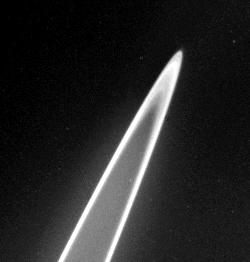don wrote:Just a thought... In the interest of "education of the masses", maybe you could add the "invisible" rings to the existing image by using a dot-dot-dot or dash pattern?
Looks like I already have...
Take care, Bob
don wrote:Just a thought... In the interest of "education of the masses", maybe you could add the "invisible" rings to the existing image by using a dot-dot-dot or dash pattern?
I guess you're using someone else's rings. The distribution texture shows only Adams and Le Verrier, with complete transparency between.Bob Hegwood wrote:Okay, I believe you... But now I'm really confused. If that's the case, then why do the *current* Neptune Ring textures (The ones you approve of as far as I know) contain the thick layers of dust between the Le Verrier Ring and the Adams Ring?
As I say, it's up to you ... it's your script. We're trying hard in the Celestia core package to show people what they'd actually see, within the limits imposed by Celestia as it develops ... although some day Celestia may also contain switches that allow you to tune up your sensitivity to light, or to switch to different wavelengths. And there are already oodles of add-ons showing people stuff they couldn't see with their naked eyes - every single one of the nebula billboards I've seen, for instance.Bob Hegwood wrote:I just thought that if the rings *do* exist, then they need to be shown somehow. Does that make sense?
You'd need to ask Praesepe how he created the specific add-on. There are images of Jupiter's rings, generated more or less the same way as the Neptune image you show above. Here's one:Bob Hegwood wrote:But then again, you've confused me some more. If Jupiter's Ring system is so dim, then how did Celestia get a texture for it? I certainly didn't create it. If I remember correctly, Praesepe contributed that piece of the Solar System. How was it contributed if their was no picture of it to go by?

granthutchison wrote:I guess you're using someone else's rings. The distribution texture shows only Adams and Le Verrier, with complete transparency between.
It's just the original file that came with the Celestia download. If you haven't backed it up, then you can get it off the CVS tree here: http://cvs.sourceforge.net/viewcvs.py/celestia/celestia/textures/lores/neptune-rings.pngBob Hegwood wrote:Okay, could you please point me to a file so that I can download and use the "official" ring texture for the script? Every texture I have thus far for Neptune's Rings has the same layer of dust between the two "visible" rings.
Code: Select all
Rings {
Inner 53150
Outer 62947
Texture "neptune-rings.png"
}Good-o. That's the effect I was aiming for. I had to increase the opacity of the ring texture considerably (otherwise the rings would be too dim to show up at all with the limited range of a computer monitor), which has led (as Fridger has pointed out to me) to the generation of an awkward ring shadow that wouldn't be detectable in reality.Evil Dr Ganymede wrote:I didn't even notice Neptune HAD a ring system in Celestia til I looked because of this thread. I can just see two tiny black lines and that's it.
don wrote:Maybe in addition to having an AlternateSurface definition, Celestia could also offer an AlternateRing definition? It would be very interesting to be watching a script and then have the two textures switched between, so folks get a good idea of how long-exposure photography really brings out things that we can't see with our human eyes.
DaveMc wrote:I'm sure a lot of people have already created alternate "current" Neptune textures but for those who haven't and want one, here's one (2K) made with a simple photoshop cloning hack:
http://members.aol.com/celestiastuff/neptune_current.zip
Don't know how realistic it is since Neptune seems to be a pretty dynamic place but at least the Great Dark Spot is gone. Here's some images to show the difference:
With Dark Spot:
Without Dark Spot:
The install.txt file within the zip archive has all the important stuff.
Dave
danielj wrote:The texture without the GDS,altough is 2k,is more pixelated and less realistic.Anyway,why don't we can assume that Hubble don't have suficient resolution to see a spot in Neptune.Why we can be sure what happened with the blue planet only based in Hubble's perspective,which is limited?
danielj wrote:The texture without the GDS,altough is 2k,is more pixelated and less realistic.
DaveMc wrote: As far as realistic, who the heck knows!
Dave
Bob wrote:How do you go about simulating a 2000 kph wind though?